Expectation Damages in Contract Law: An LLB Law Principles Essay
VerifiedAdded on 2023/06/06
|17
|4352
|312
Essay
AI Summary
This essay delves into the complex realm of expectation damages within contract law, addressing the fundamental question of whether courts should award such damages for breaches of contract. It begins by defining expectation damages as a legal remedy aimed at restoring the aggrieved party to the position they would have occupied had the contract been fully performed. The essay explores the methods of calculating these damages, considering factors such as lost profits, incidental expenses, and consequential losses, while also acknowledging the principle that damages should not be punitive. Furthermore, it examines the limitations and exceptions to expectation damages, including the duty to mitigate losses, the requirement of reasonable certainty in damage calculation, the principle of foreseeability, and considerations regarding the cost of performance. Landmark cases like Robinson v Harman and Hadley v Baxendale are discussed to illustrate these principles. The essay concludes by emphasizing the importance of understanding these legal nuances for businesses and individuals engaging in contractual agreements, providing clarity on the potential remedies available in the event of a breach.
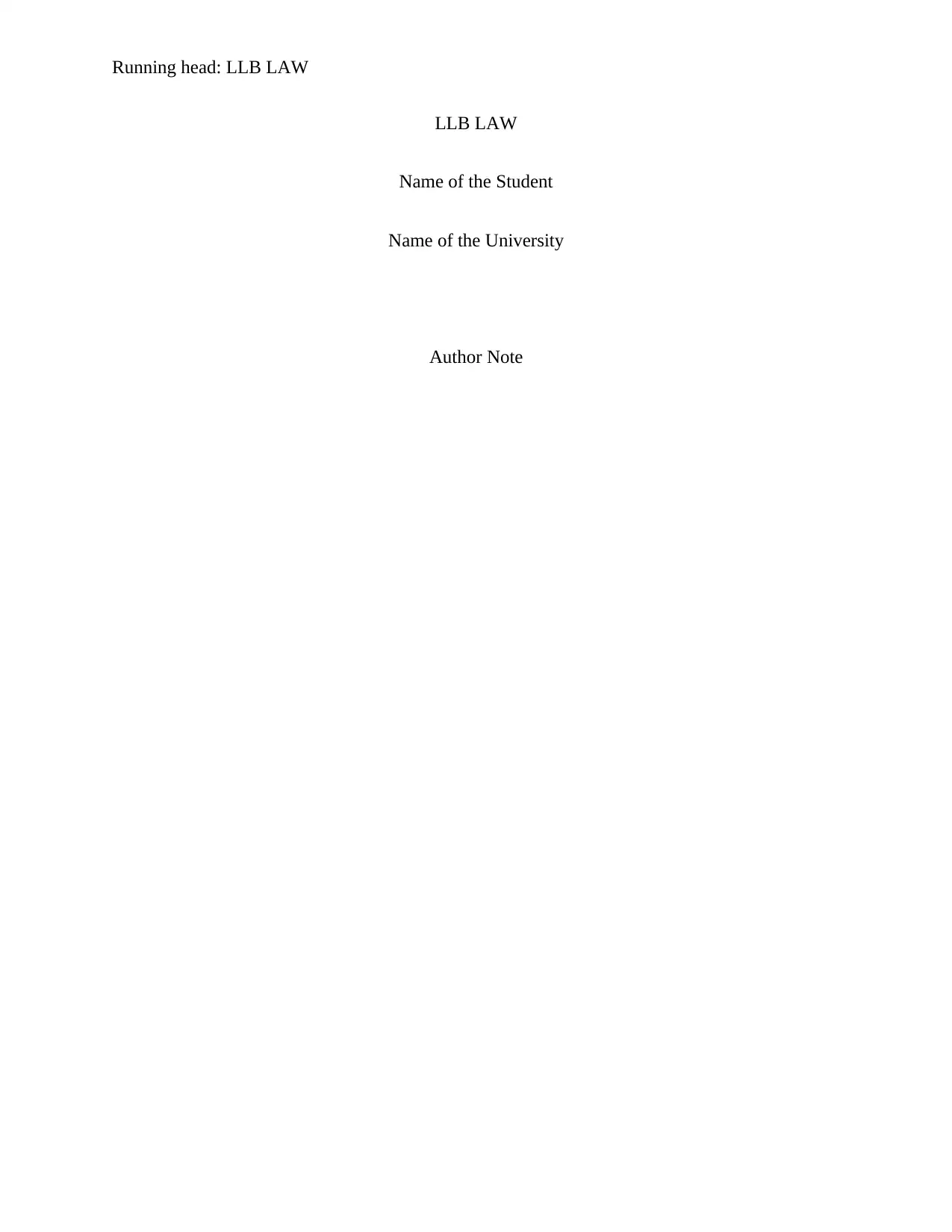
Running head: LLB LAW
LLB LAW
Name of the Student
Name of the University
Author Note
LLB LAW
Name of the Student
Name of the University
Author Note
Paraphrase This Document
Need a fresh take? Get an instant paraphrase of this document with our AI Paraphraser
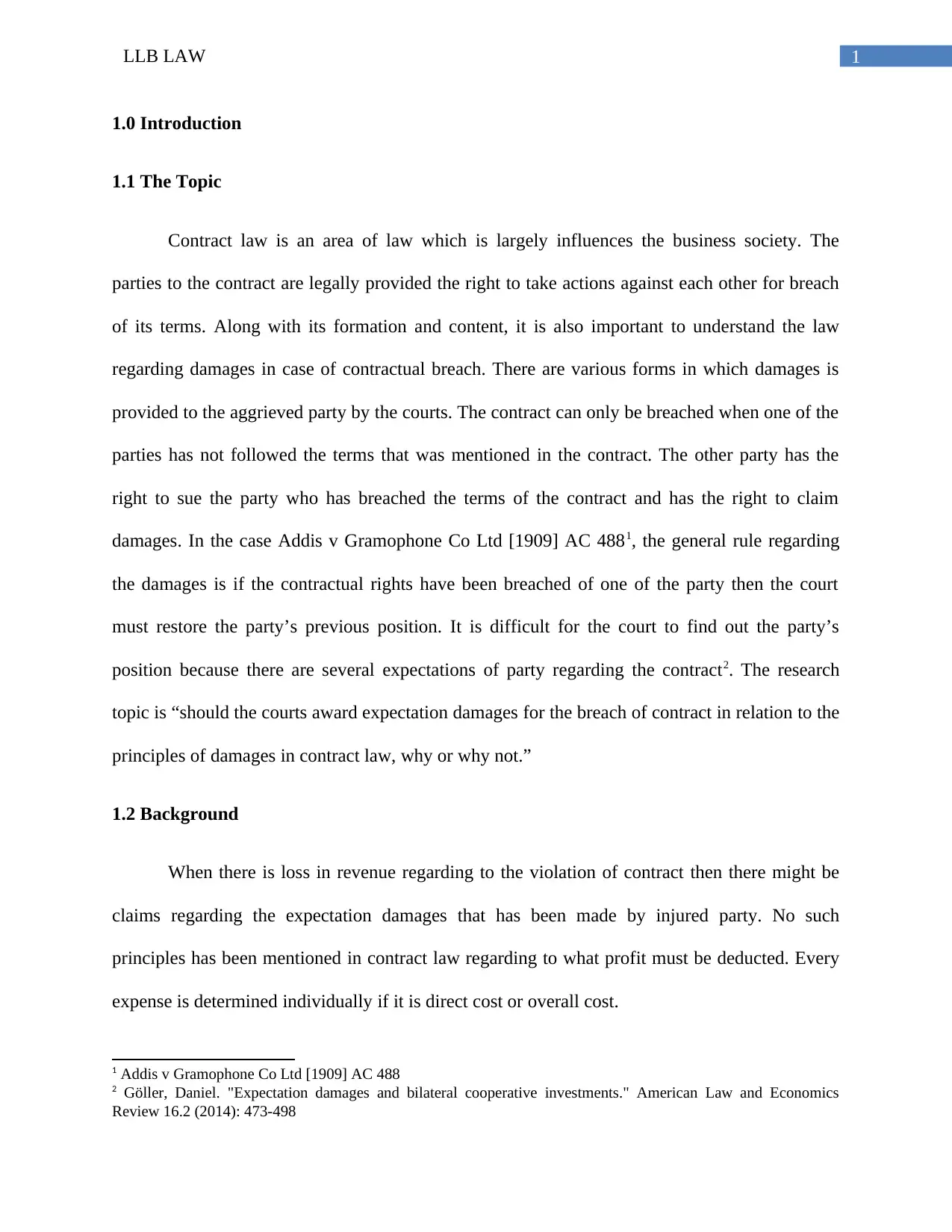
1LLB LAW
1.0 Introduction
1.1 The Topic
Contract law is an area of law which is largely influences the business society. The
parties to the contract are legally provided the right to take actions against each other for breach
of its terms. Along with its formation and content, it is also important to understand the law
regarding damages in case of contractual breach. There are various forms in which damages is
provided to the aggrieved party by the courts. The contract can only be breached when one of the
parties has not followed the terms that was mentioned in the contract. The other party has the
right to sue the party who has breached the terms of the contract and has the right to claim
damages. In the case Addis v Gramophone Co Ltd [1909] AC 4881, the general rule regarding
the damages is if the contractual rights have been breached of one of the party then the court
must restore the party’s previous position. It is difficult for the court to find out the party’s
position because there are several expectations of party regarding the contract2. The research
topic is “should the courts award expectation damages for the breach of contract in relation to the
principles of damages in contract law, why or why not.”
1.2 Background
When there is loss in revenue regarding to the violation of contract then there might be
claims regarding the expectation damages that has been made by injured party. No such
principles has been mentioned in contract law regarding to what profit must be deducted. Every
expense is determined individually if it is direct cost or overall cost.
1 Addis v Gramophone Co Ltd [1909] AC 488
2 Göller, Daniel. "Expectation damages and bilateral cooperative investments." American Law and Economics
Review 16.2 (2014): 473-498
1.0 Introduction
1.1 The Topic
Contract law is an area of law which is largely influences the business society. The
parties to the contract are legally provided the right to take actions against each other for breach
of its terms. Along with its formation and content, it is also important to understand the law
regarding damages in case of contractual breach. There are various forms in which damages is
provided to the aggrieved party by the courts. The contract can only be breached when one of the
parties has not followed the terms that was mentioned in the contract. The other party has the
right to sue the party who has breached the terms of the contract and has the right to claim
damages. In the case Addis v Gramophone Co Ltd [1909] AC 4881, the general rule regarding
the damages is if the contractual rights have been breached of one of the party then the court
must restore the party’s previous position. It is difficult for the court to find out the party’s
position because there are several expectations of party regarding the contract2. The research
topic is “should the courts award expectation damages for the breach of contract in relation to the
principles of damages in contract law, why or why not.”
1.2 Background
When there is loss in revenue regarding to the violation of contract then there might be
claims regarding the expectation damages that has been made by injured party. No such
principles has been mentioned in contract law regarding to what profit must be deducted. Every
expense is determined individually if it is direct cost or overall cost.
1 Addis v Gramophone Co Ltd [1909] AC 488
2 Göller, Daniel. "Expectation damages and bilateral cooperative investments." American Law and Economics
Review 16.2 (2014): 473-498
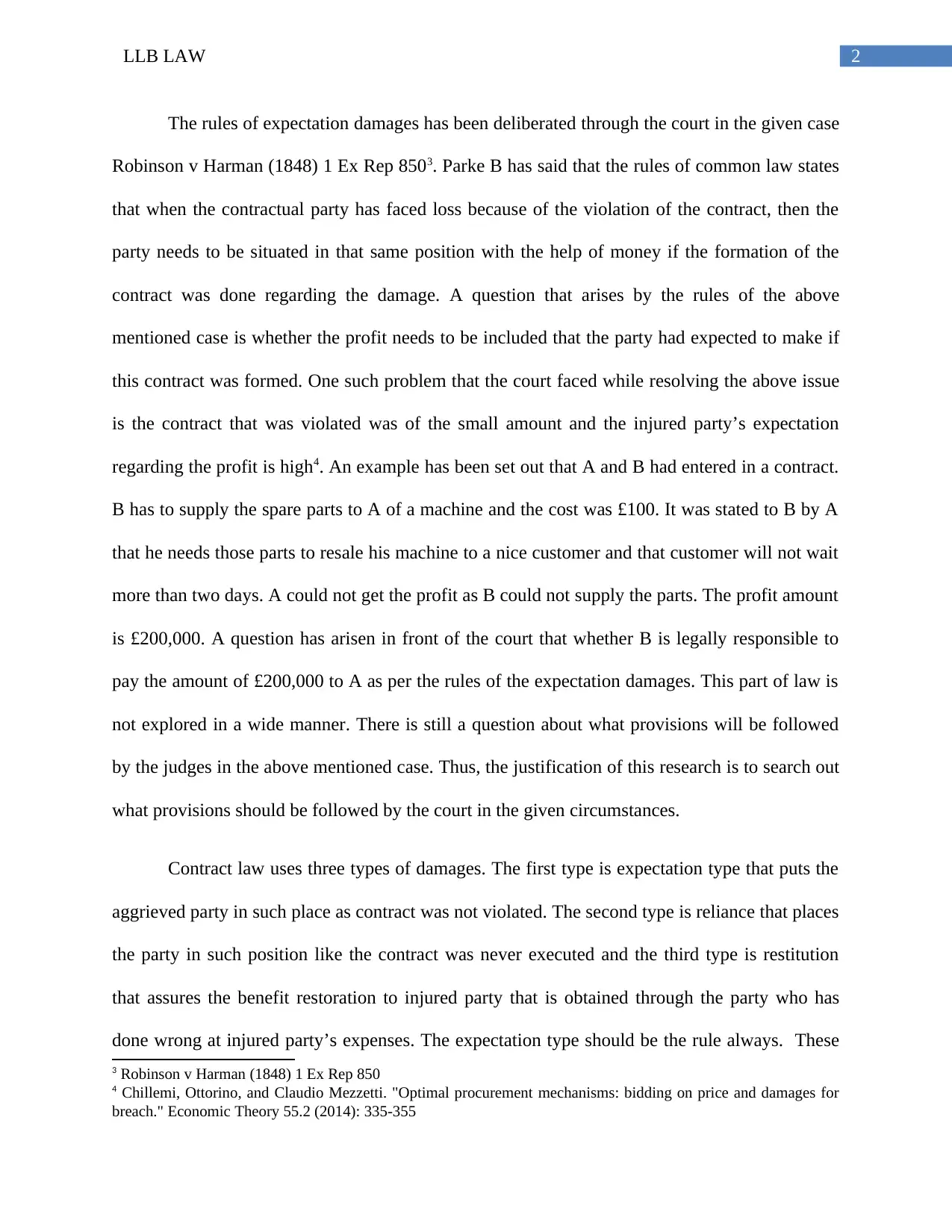
2LLB LAW
The rules of expectation damages has been deliberated through the court in the given case
Robinson v Harman (1848) 1 Ex Rep 8503. Parke B has said that the rules of common law states
that when the contractual party has faced loss because of the violation of the contract, then the
party needs to be situated in that same position with the help of money if the formation of the
contract was done regarding the damage. A question that arises by the rules of the above
mentioned case is whether the profit needs to be included that the party had expected to make if
this contract was formed. One such problem that the court faced while resolving the above issue
is the contract that was violated was of the small amount and the injured party’s expectation
regarding the profit is high4. An example has been set out that A and B had entered in a contract.
B has to supply the spare parts to A of a machine and the cost was £100. It was stated to B by A
that he needs those parts to resale his machine to a nice customer and that customer will not wait
more than two days. A could not get the profit as B could not supply the parts. The profit amount
is £200,000. A question has arisen in front of the court that whether B is legally responsible to
pay the amount of £200,000 to A as per the rules of the expectation damages. This part of law is
not explored in a wide manner. There is still a question about what provisions will be followed
by the judges in the above mentioned case. Thus, the justification of this research is to search out
what provisions should be followed by the court in the given circumstances.
Contract law uses three types of damages. The first type is expectation type that puts the
aggrieved party in such place as contract was not violated. The second type is reliance that places
the party in such position like the contract was never executed and the third type is restitution
that assures the benefit restoration to injured party that is obtained through the party who has
done wrong at injured party’s expenses. The expectation type should be the rule always. These
3 Robinson v Harman (1848) 1 Ex Rep 850
4 Chillemi, Ottorino, and Claudio Mezzetti. "Optimal procurement mechanisms: bidding on price and damages for
breach." Economic Theory 55.2 (2014): 335-355
The rules of expectation damages has been deliberated through the court in the given case
Robinson v Harman (1848) 1 Ex Rep 8503. Parke B has said that the rules of common law states
that when the contractual party has faced loss because of the violation of the contract, then the
party needs to be situated in that same position with the help of money if the formation of the
contract was done regarding the damage. A question that arises by the rules of the above
mentioned case is whether the profit needs to be included that the party had expected to make if
this contract was formed. One such problem that the court faced while resolving the above issue
is the contract that was violated was of the small amount and the injured party’s expectation
regarding the profit is high4. An example has been set out that A and B had entered in a contract.
B has to supply the spare parts to A of a machine and the cost was £100. It was stated to B by A
that he needs those parts to resale his machine to a nice customer and that customer will not wait
more than two days. A could not get the profit as B could not supply the parts. The profit amount
is £200,000. A question has arisen in front of the court that whether B is legally responsible to
pay the amount of £200,000 to A as per the rules of the expectation damages. This part of law is
not explored in a wide manner. There is still a question about what provisions will be followed
by the judges in the above mentioned case. Thus, the justification of this research is to search out
what provisions should be followed by the court in the given circumstances.
Contract law uses three types of damages. The first type is expectation type that puts the
aggrieved party in such place as contract was not violated. The second type is reliance that places
the party in such position like the contract was never executed and the third type is restitution
that assures the benefit restoration to injured party that is obtained through the party who has
done wrong at injured party’s expenses. The expectation type should be the rule always. These
3 Robinson v Harman (1848) 1 Ex Rep 850
4 Chillemi, Ottorino, and Claudio Mezzetti. "Optimal procurement mechanisms: bidding on price and damages for
breach." Economic Theory 55.2 (2014): 335-355
⊘ This is a preview!⊘
Do you want full access?
Subscribe today to unlock all pages.

Trusted by 1+ million students worldwide
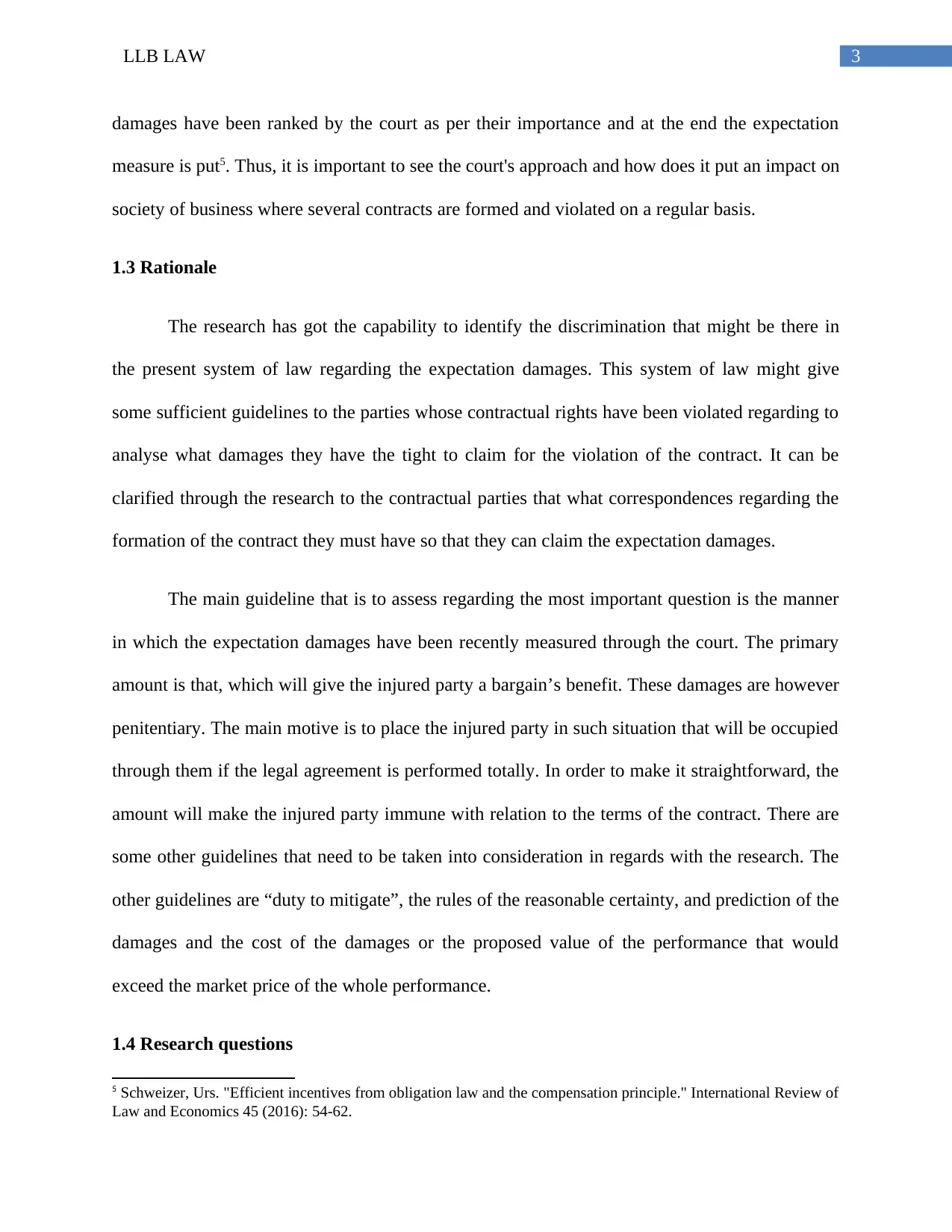
3LLB LAW
damages have been ranked by the court as per their importance and at the end the expectation
measure is put5. Thus, it is important to see the court's approach and how does it put an impact on
society of business where several contracts are formed and violated on a regular basis.
1.3 Rationale
The research has got the capability to identify the discrimination that might be there in
the present system of law regarding the expectation damages. This system of law might give
some sufficient guidelines to the parties whose contractual rights have been violated regarding to
analyse what damages they have the tight to claim for the violation of the contract. It can be
clarified through the research to the contractual parties that what correspondences regarding the
formation of the contract they must have so that they can claim the expectation damages.
The main guideline that is to assess regarding the most important question is the manner
in which the expectation damages have been recently measured through the court. The primary
amount is that, which will give the injured party a bargain’s benefit. These damages are however
penitentiary. The main motive is to place the injured party in such situation that will be occupied
through them if the legal agreement is performed totally. In order to make it straightforward, the
amount will make the injured party immune with relation to the terms of the contract. There are
some other guidelines that need to be taken into consideration in regards with the research. The
other guidelines are “duty to mitigate”, the rules of the reasonable certainty, and prediction of the
damages and the cost of the damages or the proposed value of the performance that would
exceed the market price of the whole performance.
1.4 Research questions
5 Schweizer, Urs. "Efficient incentives from obligation law and the compensation principle." International Review of
Law and Economics 45 (2016): 54-62.
damages have been ranked by the court as per their importance and at the end the expectation
measure is put5. Thus, it is important to see the court's approach and how does it put an impact on
society of business where several contracts are formed and violated on a regular basis.
1.3 Rationale
The research has got the capability to identify the discrimination that might be there in
the present system of law regarding the expectation damages. This system of law might give
some sufficient guidelines to the parties whose contractual rights have been violated regarding to
analyse what damages they have the tight to claim for the violation of the contract. It can be
clarified through the research to the contractual parties that what correspondences regarding the
formation of the contract they must have so that they can claim the expectation damages.
The main guideline that is to assess regarding the most important question is the manner
in which the expectation damages have been recently measured through the court. The primary
amount is that, which will give the injured party a bargain’s benefit. These damages are however
penitentiary. The main motive is to place the injured party in such situation that will be occupied
through them if the legal agreement is performed totally. In order to make it straightforward, the
amount will make the injured party immune with relation to the terms of the contract. There are
some other guidelines that need to be taken into consideration in regards with the research. The
other guidelines are “duty to mitigate”, the rules of the reasonable certainty, and prediction of the
damages and the cost of the damages or the proposed value of the performance that would
exceed the market price of the whole performance.
1.4 Research questions
5 Schweizer, Urs. "Efficient incentives from obligation law and the compensation principle." International Review of
Law and Economics 45 (2016): 54-62.
Paraphrase This Document
Need a fresh take? Get an instant paraphrase of this document with our AI Paraphraser
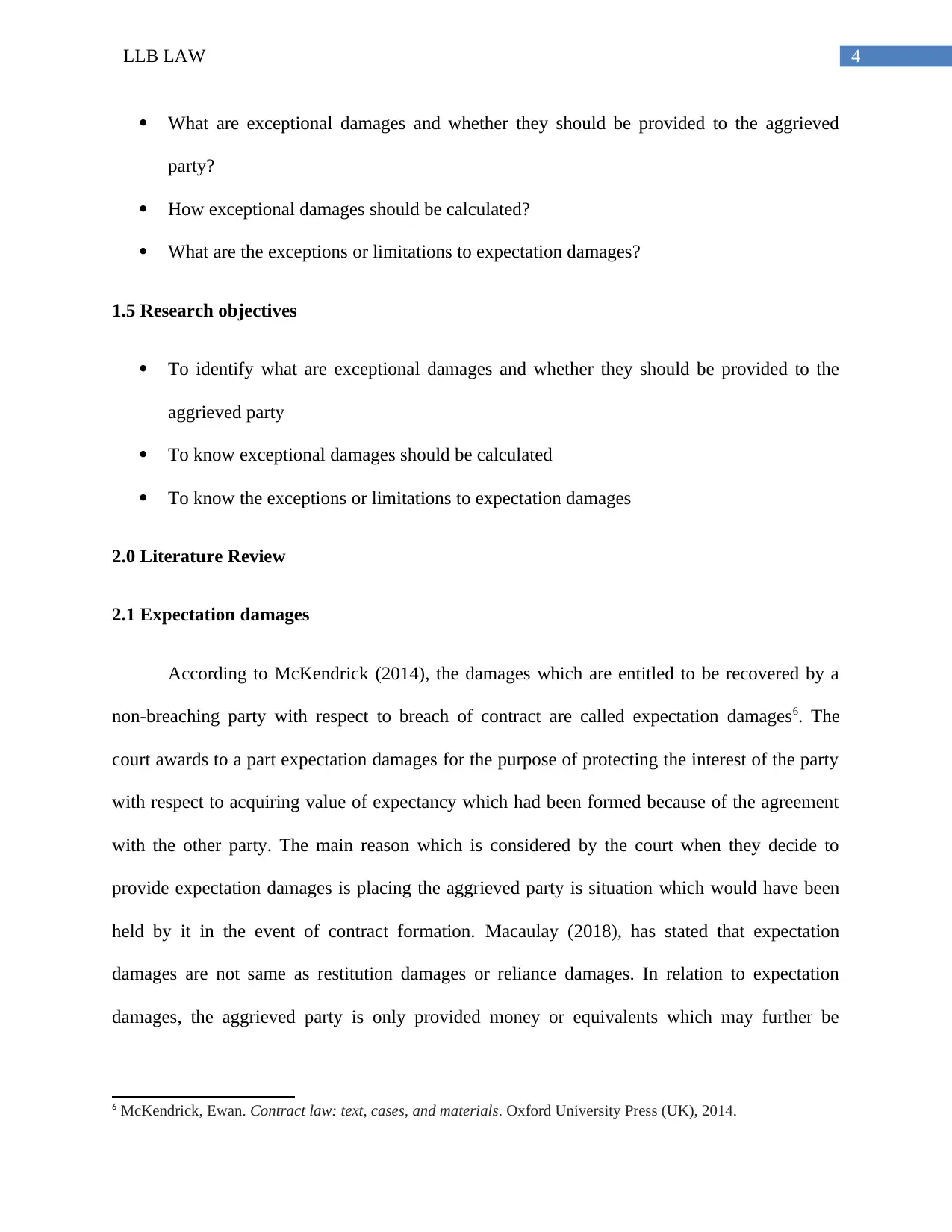
4LLB LAW
What are exceptional damages and whether they should be provided to the aggrieved
party?
How exceptional damages should be calculated?
What are the exceptions or limitations to expectation damages?
1.5 Research objectives
To identify what are exceptional damages and whether they should be provided to the
aggrieved party
To know exceptional damages should be calculated
To know the exceptions or limitations to expectation damages
2.0 Literature Review
2.1 Expectation damages
According to McKendrick (2014), the damages which are entitled to be recovered by a
non-breaching party with respect to breach of contract are called expectation damages6. The
court awards to a part expectation damages for the purpose of protecting the interest of the party
with respect to acquiring value of expectancy which had been formed because of the agreement
with the other party. The main reason which is considered by the court when they decide to
provide expectation damages is placing the aggrieved party is situation which would have been
held by it in the event of contract formation. Macaulay (2018), has stated that expectation
damages are not same as restitution damages or reliance damages. In relation to expectation
damages, the aggrieved party is only provided money or equivalents which may further be
6 McKendrick, Ewan. Contract law: text, cases, and materials. Oxford University Press (UK), 2014.
What are exceptional damages and whether they should be provided to the aggrieved
party?
How exceptional damages should be calculated?
What are the exceptions or limitations to expectation damages?
1.5 Research objectives
To identify what are exceptional damages and whether they should be provided to the
aggrieved party
To know exceptional damages should be calculated
To know the exceptions or limitations to expectation damages
2.0 Literature Review
2.1 Expectation damages
According to McKendrick (2014), the damages which are entitled to be recovered by a
non-breaching party with respect to breach of contract are called expectation damages6. The
court awards to a part expectation damages for the purpose of protecting the interest of the party
with respect to acquiring value of expectancy which had been formed because of the agreement
with the other party. The main reason which is considered by the court when they decide to
provide expectation damages is placing the aggrieved party is situation which would have been
held by it in the event of contract formation. Macaulay (2018), has stated that expectation
damages are not same as restitution damages or reliance damages. In relation to expectation
damages, the aggrieved party is only provided money or equivalents which may further be
6 McKendrick, Ewan. Contract law: text, cases, and materials. Oxford University Press (UK), 2014.
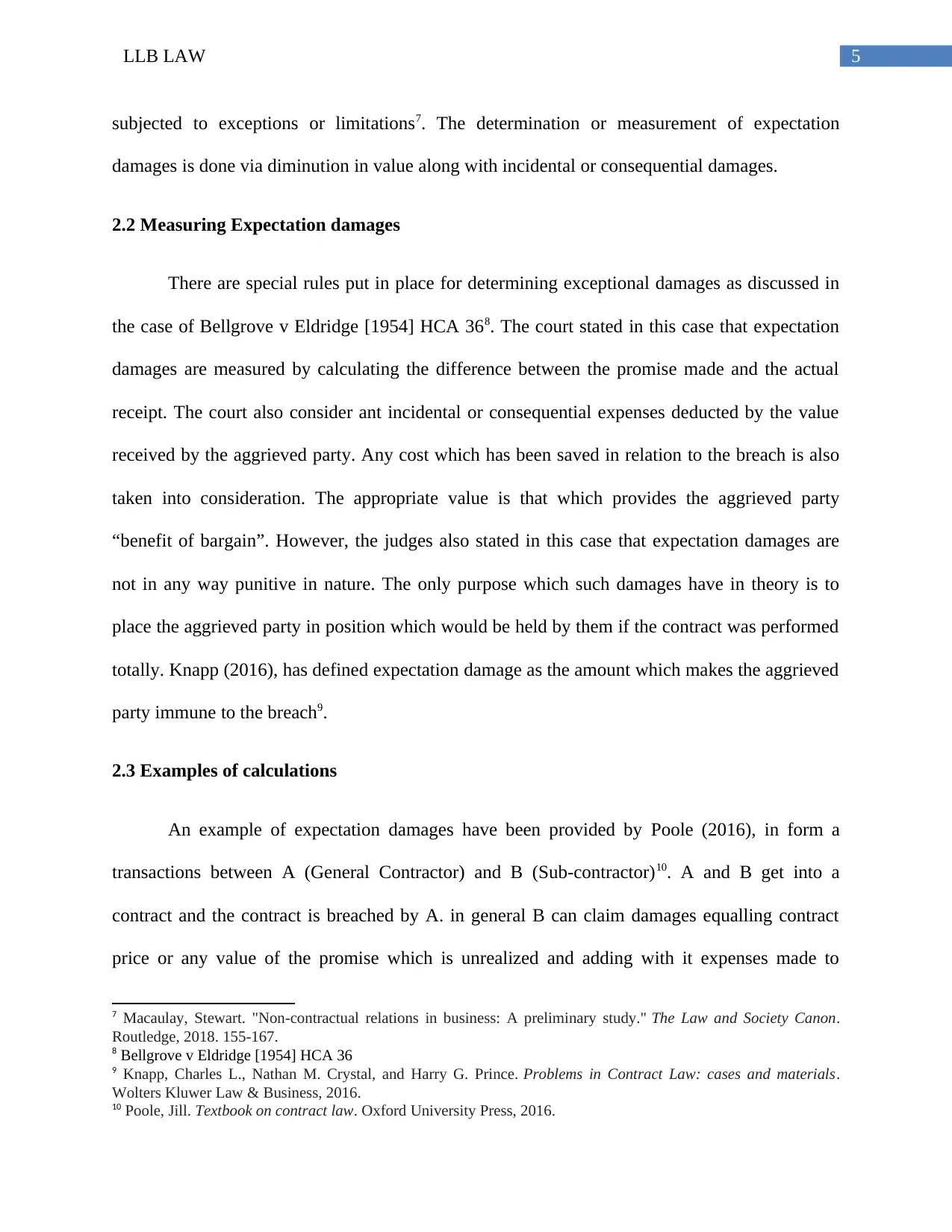
5LLB LAW
subjected to exceptions or limitations7. The determination or measurement of expectation
damages is done via diminution in value along with incidental or consequential damages.
2.2 Measuring Expectation damages
There are special rules put in place for determining exceptional damages as discussed in
the case of Bellgrove v Eldridge [1954] HCA 368. The court stated in this case that expectation
damages are measured by calculating the difference between the promise made and the actual
receipt. The court also consider ant incidental or consequential expenses deducted by the value
received by the aggrieved party. Any cost which has been saved in relation to the breach is also
taken into consideration. The appropriate value is that which provides the aggrieved party
“benefit of bargain”. However, the judges also stated in this case that expectation damages are
not in any way punitive in nature. The only purpose which such damages have in theory is to
place the aggrieved party in position which would be held by them if the contract was performed
totally. Knapp (2016), has defined expectation damage as the amount which makes the aggrieved
party immune to the breach9.
2.3 Examples of calculations
An example of expectation damages have been provided by Poole (2016), in form a
transactions between A (General Contractor) and B (Sub-contractor)10. A and B get into a
contract and the contract is breached by A. in general B can claim damages equalling contract
price or any value of the promise which is unrealized and adding with it expenses made to
7 Macaulay, Stewart. "Non-contractual relations in business: A preliminary study." The Law and Society Canon.
Routledge, 2018. 155-167.
8 Bellgrove v Eldridge [1954] HCA 36
9 Knapp, Charles L., Nathan M. Crystal, and Harry G. Prince. Problems in Contract Law: cases and materials.
Wolters Kluwer Law & Business, 2016.
10 Poole, Jill. Textbook on contract law. Oxford University Press, 2016.
subjected to exceptions or limitations7. The determination or measurement of expectation
damages is done via diminution in value along with incidental or consequential damages.
2.2 Measuring Expectation damages
There are special rules put in place for determining exceptional damages as discussed in
the case of Bellgrove v Eldridge [1954] HCA 368. The court stated in this case that expectation
damages are measured by calculating the difference between the promise made and the actual
receipt. The court also consider ant incidental or consequential expenses deducted by the value
received by the aggrieved party. Any cost which has been saved in relation to the breach is also
taken into consideration. The appropriate value is that which provides the aggrieved party
“benefit of bargain”. However, the judges also stated in this case that expectation damages are
not in any way punitive in nature. The only purpose which such damages have in theory is to
place the aggrieved party in position which would be held by them if the contract was performed
totally. Knapp (2016), has defined expectation damage as the amount which makes the aggrieved
party immune to the breach9.
2.3 Examples of calculations
An example of expectation damages have been provided by Poole (2016), in form a
transactions between A (General Contractor) and B (Sub-contractor)10. A and B get into a
contract and the contract is breached by A. in general B can claim damages equalling contract
price or any value of the promise which is unrealized and adding with it expenses made to
7 Macaulay, Stewart. "Non-contractual relations in business: A preliminary study." The Law and Society Canon.
Routledge, 2018. 155-167.
8 Bellgrove v Eldridge [1954] HCA 36
9 Knapp, Charles L., Nathan M. Crystal, and Harry G. Prince. Problems in Contract Law: cases and materials.
Wolters Kluwer Law & Business, 2016.
10 Poole, Jill. Textbook on contract law. Oxford University Press, 2016.
⊘ This is a preview!⊘
Do you want full access?
Subscribe today to unlock all pages.

Trusted by 1+ million students worldwide
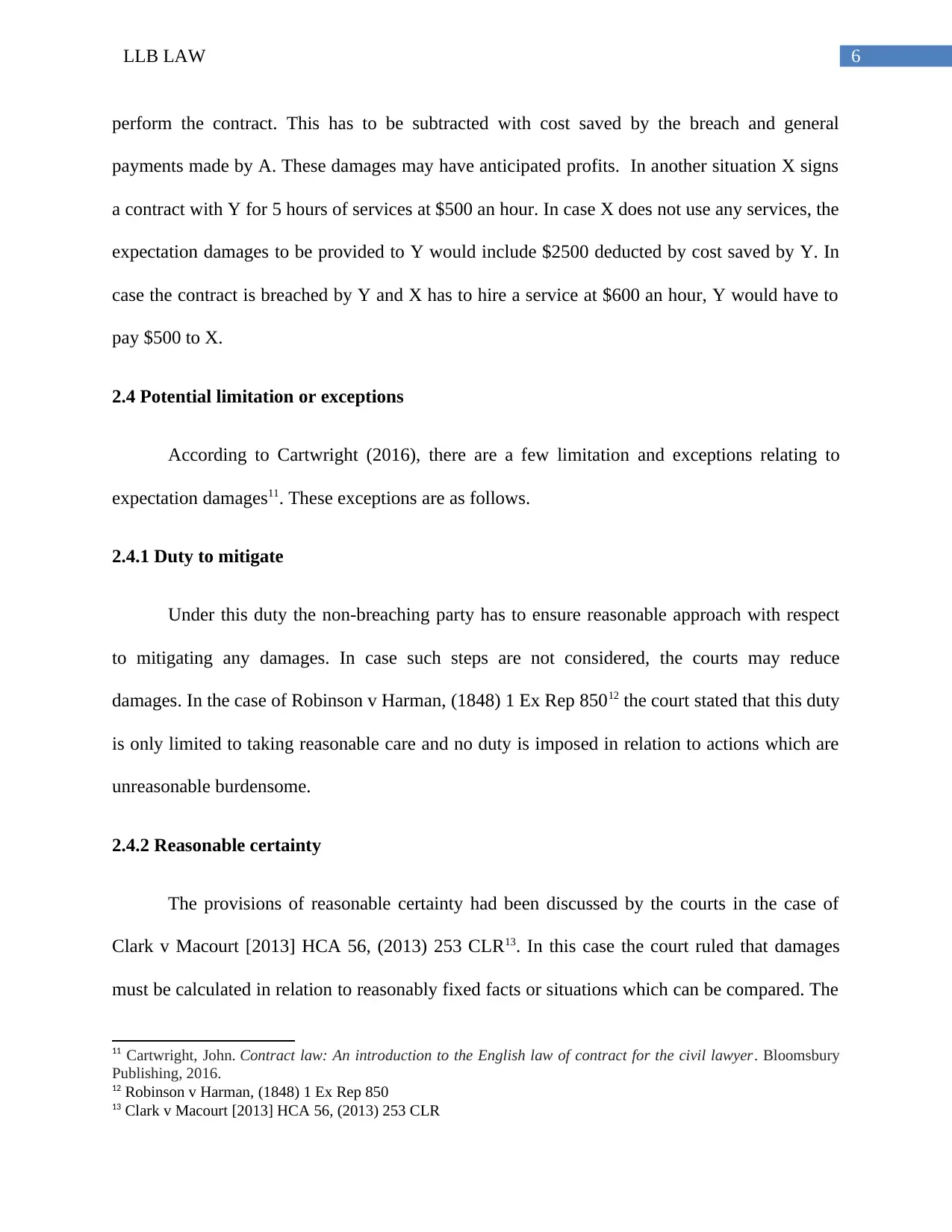
6LLB LAW
perform the contract. This has to be subtracted with cost saved by the breach and general
payments made by A. These damages may have anticipated profits. In another situation X signs
a contract with Y for 5 hours of services at $500 an hour. In case X does not use any services, the
expectation damages to be provided to Y would include $2500 deducted by cost saved by Y. In
case the contract is breached by Y and X has to hire a service at $600 an hour, Y would have to
pay $500 to X.
2.4 Potential limitation or exceptions
According to Cartwright (2016), there are a few limitation and exceptions relating to
expectation damages11. These exceptions are as follows.
2.4.1 Duty to mitigate
Under this duty the non-breaching party has to ensure reasonable approach with respect
to mitigating any damages. In case such steps are not considered, the courts may reduce
damages. In the case of Robinson v Harman, (1848) 1 Ex Rep 85012 the court stated that this duty
is only limited to taking reasonable care and no duty is imposed in relation to actions which are
unreasonable burdensome.
2.4.2 Reasonable certainty
The provisions of reasonable certainty had been discussed by the courts in the case of
Clark v Macourt [2013] HCA 56, (2013) 253 CLR13. In this case the court ruled that damages
must be calculated in relation to reasonably fixed facts or situations which can be compared. The
11 Cartwright, John. Contract law: An introduction to the English law of contract for the civil lawyer. Bloomsbury
Publishing, 2016.
12 Robinson v Harman, (1848) 1 Ex Rep 850
13 Clark v Macourt [2013] HCA 56, (2013) 253 CLR
perform the contract. This has to be subtracted with cost saved by the breach and general
payments made by A. These damages may have anticipated profits. In another situation X signs
a contract with Y for 5 hours of services at $500 an hour. In case X does not use any services, the
expectation damages to be provided to Y would include $2500 deducted by cost saved by Y. In
case the contract is breached by Y and X has to hire a service at $600 an hour, Y would have to
pay $500 to X.
2.4 Potential limitation or exceptions
According to Cartwright (2016), there are a few limitation and exceptions relating to
expectation damages11. These exceptions are as follows.
2.4.1 Duty to mitigate
Under this duty the non-breaching party has to ensure reasonable approach with respect
to mitigating any damages. In case such steps are not considered, the courts may reduce
damages. In the case of Robinson v Harman, (1848) 1 Ex Rep 85012 the court stated that this duty
is only limited to taking reasonable care and no duty is imposed in relation to actions which are
unreasonable burdensome.
2.4.2 Reasonable certainty
The provisions of reasonable certainty had been discussed by the courts in the case of
Clark v Macourt [2013] HCA 56, (2013) 253 CLR13. In this case the court ruled that damages
must be calculated in relation to reasonably fixed facts or situations which can be compared. The
11 Cartwright, John. Contract law: An introduction to the English law of contract for the civil lawyer. Bloomsbury
Publishing, 2016.
12 Robinson v Harman, (1848) 1 Ex Rep 850
13 Clark v Macourt [2013] HCA 56, (2013) 253 CLR
Paraphrase This Document
Need a fresh take? Get an instant paraphrase of this document with our AI Paraphraser
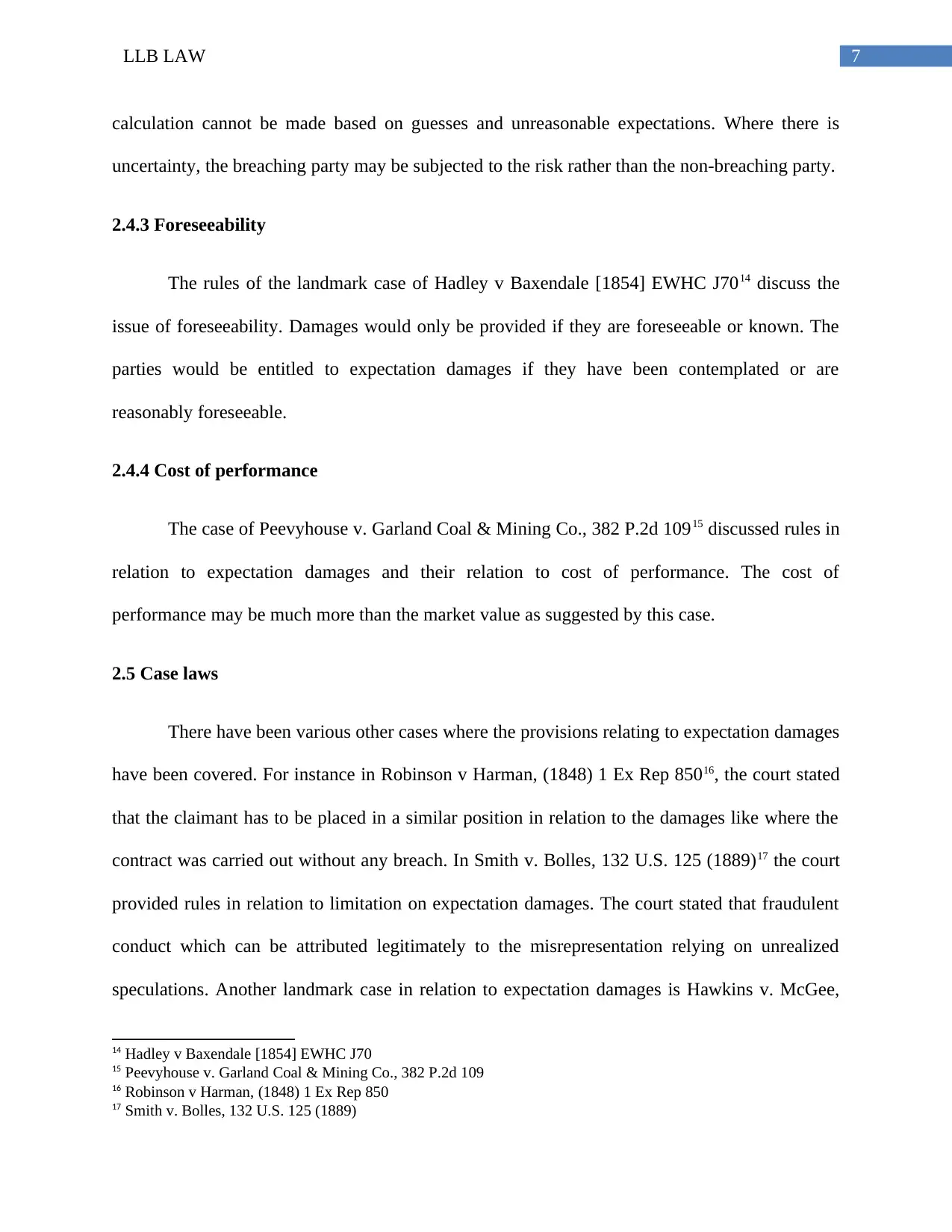
7LLB LAW
calculation cannot be made based on guesses and unreasonable expectations. Where there is
uncertainty, the breaching party may be subjected to the risk rather than the non-breaching party.
2.4.3 Foreseeability
The rules of the landmark case of Hadley v Baxendale [1854] EWHC J7014 discuss the
issue of foreseeability. Damages would only be provided if they are foreseeable or known. The
parties would be entitled to expectation damages if they have been contemplated or are
reasonably foreseeable.
2.4.4 Cost of performance
The case of Peevyhouse v. Garland Coal & Mining Co., 382 P.2d 10915 discussed rules in
relation to expectation damages and their relation to cost of performance. The cost of
performance may be much more than the market value as suggested by this case.
2.5 Case laws
There have been various other cases where the provisions relating to expectation damages
have been covered. For instance in Robinson v Harman, (1848) 1 Ex Rep 85016, the court stated
that the claimant has to be placed in a similar position in relation to the damages like where the
contract was carried out without any breach. In Smith v. Bolles, 132 U.S. 125 (1889)17 the court
provided rules in relation to limitation on expectation damages. The court stated that fraudulent
conduct which can be attributed legitimately to the misrepresentation relying on unrealized
speculations. Another landmark case in relation to expectation damages is Hawkins v. McGee,
14 Hadley v Baxendale [1854] EWHC J70
15 Peevyhouse v. Garland Coal & Mining Co., 382 P.2d 109
16 Robinson v Harman, (1848) 1 Ex Rep 850
17 Smith v. Bolles, 132 U.S. 125 (1889)
calculation cannot be made based on guesses and unreasonable expectations. Where there is
uncertainty, the breaching party may be subjected to the risk rather than the non-breaching party.
2.4.3 Foreseeability
The rules of the landmark case of Hadley v Baxendale [1854] EWHC J7014 discuss the
issue of foreseeability. Damages would only be provided if they are foreseeable or known. The
parties would be entitled to expectation damages if they have been contemplated or are
reasonably foreseeable.
2.4.4 Cost of performance
The case of Peevyhouse v. Garland Coal & Mining Co., 382 P.2d 10915 discussed rules in
relation to expectation damages and their relation to cost of performance. The cost of
performance may be much more than the market value as suggested by this case.
2.5 Case laws
There have been various other cases where the provisions relating to expectation damages
have been covered. For instance in Robinson v Harman, (1848) 1 Ex Rep 85016, the court stated
that the claimant has to be placed in a similar position in relation to the damages like where the
contract was carried out without any breach. In Smith v. Bolles, 132 U.S. 125 (1889)17 the court
provided rules in relation to limitation on expectation damages. The court stated that fraudulent
conduct which can be attributed legitimately to the misrepresentation relying on unrealized
speculations. Another landmark case in relation to expectation damages is Hawkins v. McGee,
14 Hadley v Baxendale [1854] EWHC J70
15 Peevyhouse v. Garland Coal & Mining Co., 382 P.2d 109
16 Robinson v Harman, (1848) 1 Ex Rep 850
17 Smith v. Bolles, 132 U.S. 125 (1889)
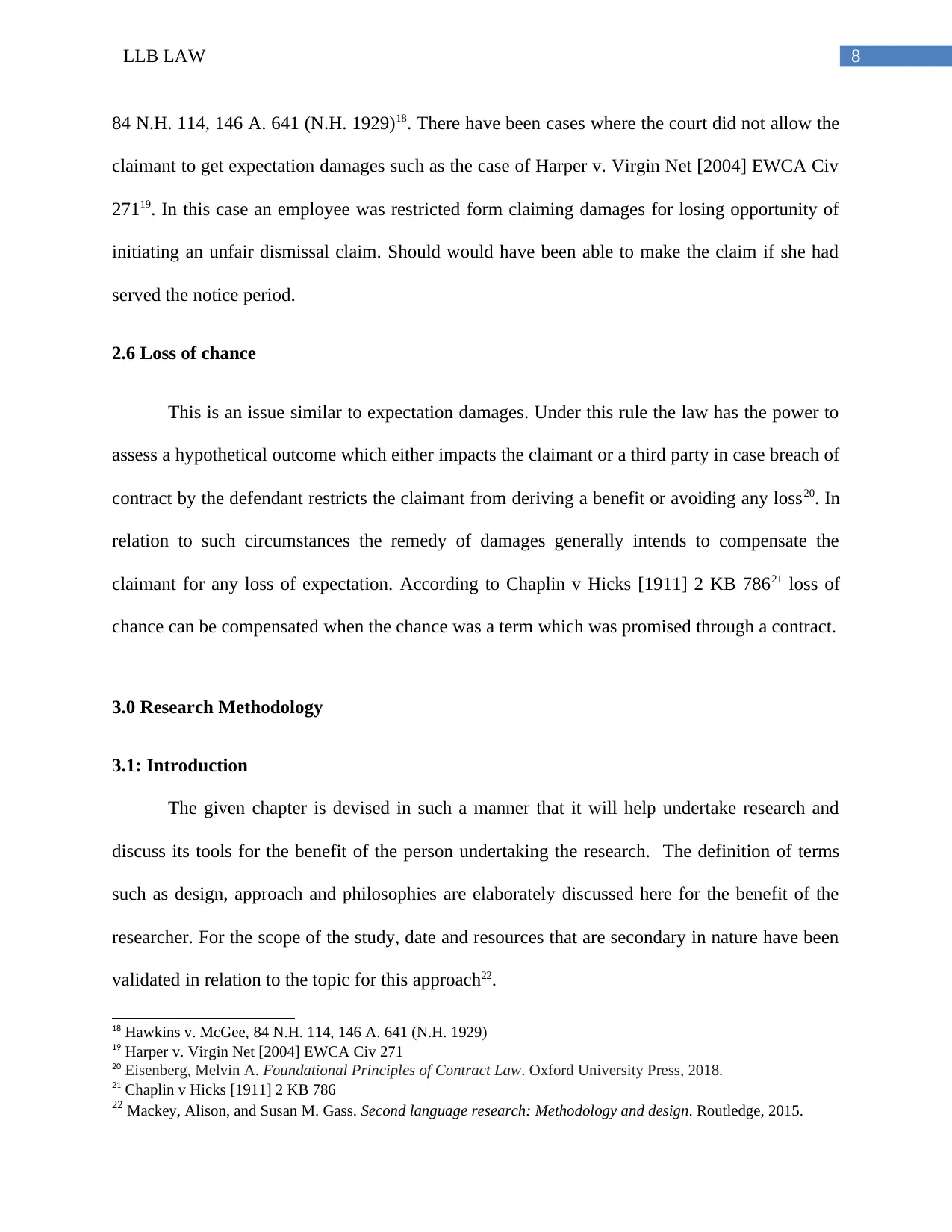
8LLB LAW
84 N.H. 114, 146 A. 641 (N.H. 1929)18. There have been cases where the court did not allow the
claimant to get expectation damages such as the case of Harper v. Virgin Net [2004] EWCA Civ
27119. In this case an employee was restricted form claiming damages for losing opportunity of
initiating an unfair dismissal claim. Should would have been able to make the claim if she had
served the notice period.
2.6 Loss of chance
This is an issue similar to expectation damages. Under this rule the law has the power to
assess a hypothetical outcome which either impacts the claimant or a third party in case breach of
contract by the defendant restricts the claimant from deriving a benefit or avoiding any loss20. In
relation to such circumstances the remedy of damages generally intends to compensate the
claimant for any loss of expectation. According to Chaplin v Hicks [1911] 2 KB 78621 loss of
chance can be compensated when the chance was a term which was promised through a contract.
3.0 Research Methodology
3.1: Introduction
The given chapter is devised in such a manner that it will help undertake research and
discuss its tools for the benefit of the person undertaking the research. The definition of terms
such as design, approach and philosophies are elaborately discussed here for the benefit of the
researcher. For the scope of the study, date and resources that are secondary in nature have been
validated in relation to the topic for this approach22.
18 Hawkins v. McGee, 84 N.H. 114, 146 A. 641 (N.H. 1929)
19 Harper v. Virgin Net [2004] EWCA Civ 271
20 Eisenberg, Melvin A. Foundational Principles of Contract Law. Oxford University Press, 2018.
21 Chaplin v Hicks [1911] 2 KB 786
22 Mackey, Alison, and Susan M. Gass. Second language research: Methodology and design. Routledge, 2015.
84 N.H. 114, 146 A. 641 (N.H. 1929)18. There have been cases where the court did not allow the
claimant to get expectation damages such as the case of Harper v. Virgin Net [2004] EWCA Civ
27119. In this case an employee was restricted form claiming damages for losing opportunity of
initiating an unfair dismissal claim. Should would have been able to make the claim if she had
served the notice period.
2.6 Loss of chance
This is an issue similar to expectation damages. Under this rule the law has the power to
assess a hypothetical outcome which either impacts the claimant or a third party in case breach of
contract by the defendant restricts the claimant from deriving a benefit or avoiding any loss20. In
relation to such circumstances the remedy of damages generally intends to compensate the
claimant for any loss of expectation. According to Chaplin v Hicks [1911] 2 KB 78621 loss of
chance can be compensated when the chance was a term which was promised through a contract.
3.0 Research Methodology
3.1: Introduction
The given chapter is devised in such a manner that it will help undertake research and
discuss its tools for the benefit of the person undertaking the research. The definition of terms
such as design, approach and philosophies are elaborately discussed here for the benefit of the
researcher. For the scope of the study, date and resources that are secondary in nature have been
validated in relation to the topic for this approach22.
18 Hawkins v. McGee, 84 N.H. 114, 146 A. 641 (N.H. 1929)
19 Harper v. Virgin Net [2004] EWCA Civ 271
20 Eisenberg, Melvin A. Foundational Principles of Contract Law. Oxford University Press, 2018.
21 Chaplin v Hicks [1911] 2 KB 786
22 Mackey, Alison, and Susan M. Gass. Second language research: Methodology and design. Routledge, 2015.
⊘ This is a preview!⊘
Do you want full access?
Subscribe today to unlock all pages.

Trusted by 1+ million students worldwide
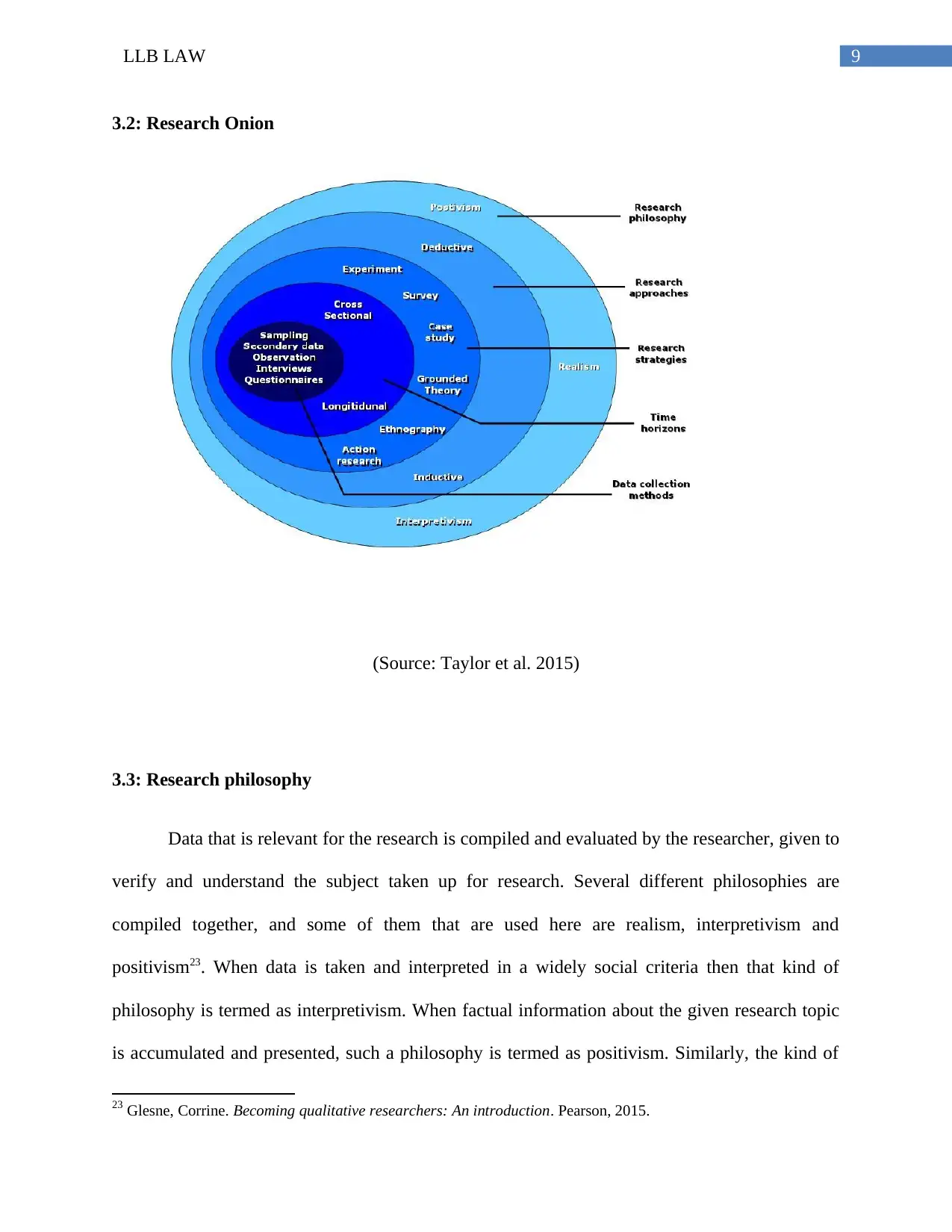
9LLB LAW
3.2: Research Onion
(Source: Taylor et al. 2015)
3.3: Research philosophy
Data that is relevant for the research is compiled and evaluated by the researcher, given to
verify and understand the subject taken up for research. Several different philosophies are
compiled together, and some of them that are used here are realism, interpretivism and
positivism23. When data is taken and interpreted in a widely social criteria then that kind of
philosophy is termed as interpretivism. When factual information about the given research topic
is accumulated and presented, such a philosophy is termed as positivism. Similarly, the kind of
23 Glesne, Corrine. Becoming qualitative researchers: An introduction. Pearson, 2015.
3.2: Research Onion
(Source: Taylor et al. 2015)
3.3: Research philosophy
Data that is relevant for the research is compiled and evaluated by the researcher, given to
verify and understand the subject taken up for research. Several different philosophies are
compiled together, and some of them that are used here are realism, interpretivism and
positivism23. When data is taken and interpreted in a widely social criteria then that kind of
philosophy is termed as interpretivism. When factual information about the given research topic
is accumulated and presented, such a philosophy is termed as positivism. Similarly, the kind of
23 Glesne, Corrine. Becoming qualitative researchers: An introduction. Pearson, 2015.
Paraphrase This Document
Need a fresh take? Get an instant paraphrase of this document with our AI Paraphraser
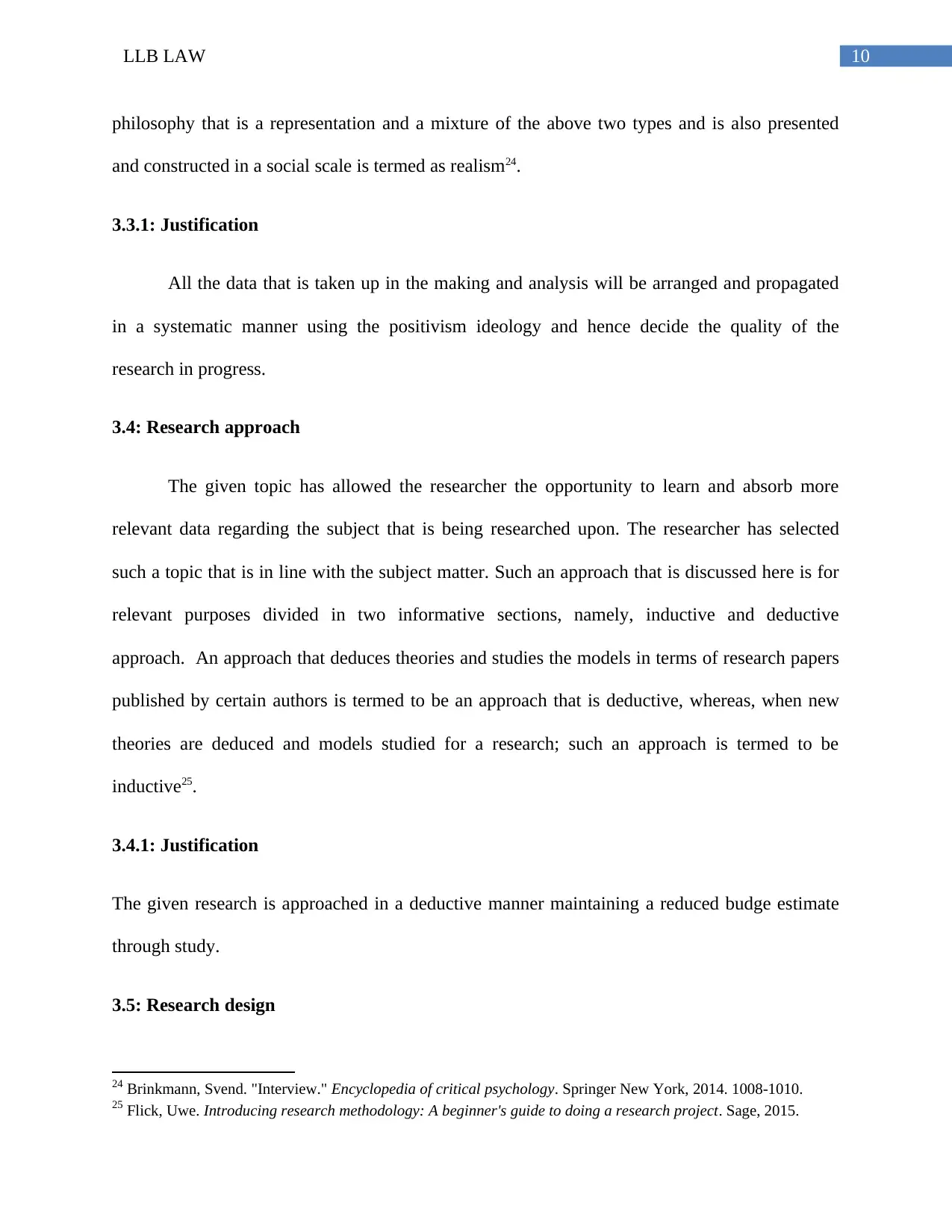
10LLB LAW
philosophy that is a representation and a mixture of the above two types and is also presented
and constructed in a social scale is termed as realism24.
3.3.1: Justification
All the data that is taken up in the making and analysis will be arranged and propagated
in a systematic manner using the positivism ideology and hence decide the quality of the
research in progress.
3.4: Research approach
The given topic has allowed the researcher the opportunity to learn and absorb more
relevant data regarding the subject that is being researched upon. The researcher has selected
such a topic that is in line with the subject matter. Such an approach that is discussed here is for
relevant purposes divided in two informative sections, namely, inductive and deductive
approach. An approach that deduces theories and studies the models in terms of research papers
published by certain authors is termed to be an approach that is deductive, whereas, when new
theories are deduced and models studied for a research; such an approach is termed to be
inductive25.
3.4.1: Justification
The given research is approached in a deductive manner maintaining a reduced budge estimate
through study.
3.5: Research design
24 Brinkmann, Svend. "Interview." Encyclopedia of critical psychology. Springer New York, 2014. 1008-1010.
25 Flick, Uwe. Introducing research methodology: A beginner's guide to doing a research project. Sage, 2015.
philosophy that is a representation and a mixture of the above two types and is also presented
and constructed in a social scale is termed as realism24.
3.3.1: Justification
All the data that is taken up in the making and analysis will be arranged and propagated
in a systematic manner using the positivism ideology and hence decide the quality of the
research in progress.
3.4: Research approach
The given topic has allowed the researcher the opportunity to learn and absorb more
relevant data regarding the subject that is being researched upon. The researcher has selected
such a topic that is in line with the subject matter. Such an approach that is discussed here is for
relevant purposes divided in two informative sections, namely, inductive and deductive
approach. An approach that deduces theories and studies the models in terms of research papers
published by certain authors is termed to be an approach that is deductive, whereas, when new
theories are deduced and models studied for a research; such an approach is termed to be
inductive25.
3.4.1: Justification
The given research is approached in a deductive manner maintaining a reduced budge estimate
through study.
3.5: Research design
24 Brinkmann, Svend. "Interview." Encyclopedia of critical psychology. Springer New York, 2014. 1008-1010.
25 Flick, Uwe. Introducing research methodology: A beginner's guide to doing a research project. Sage, 2015.
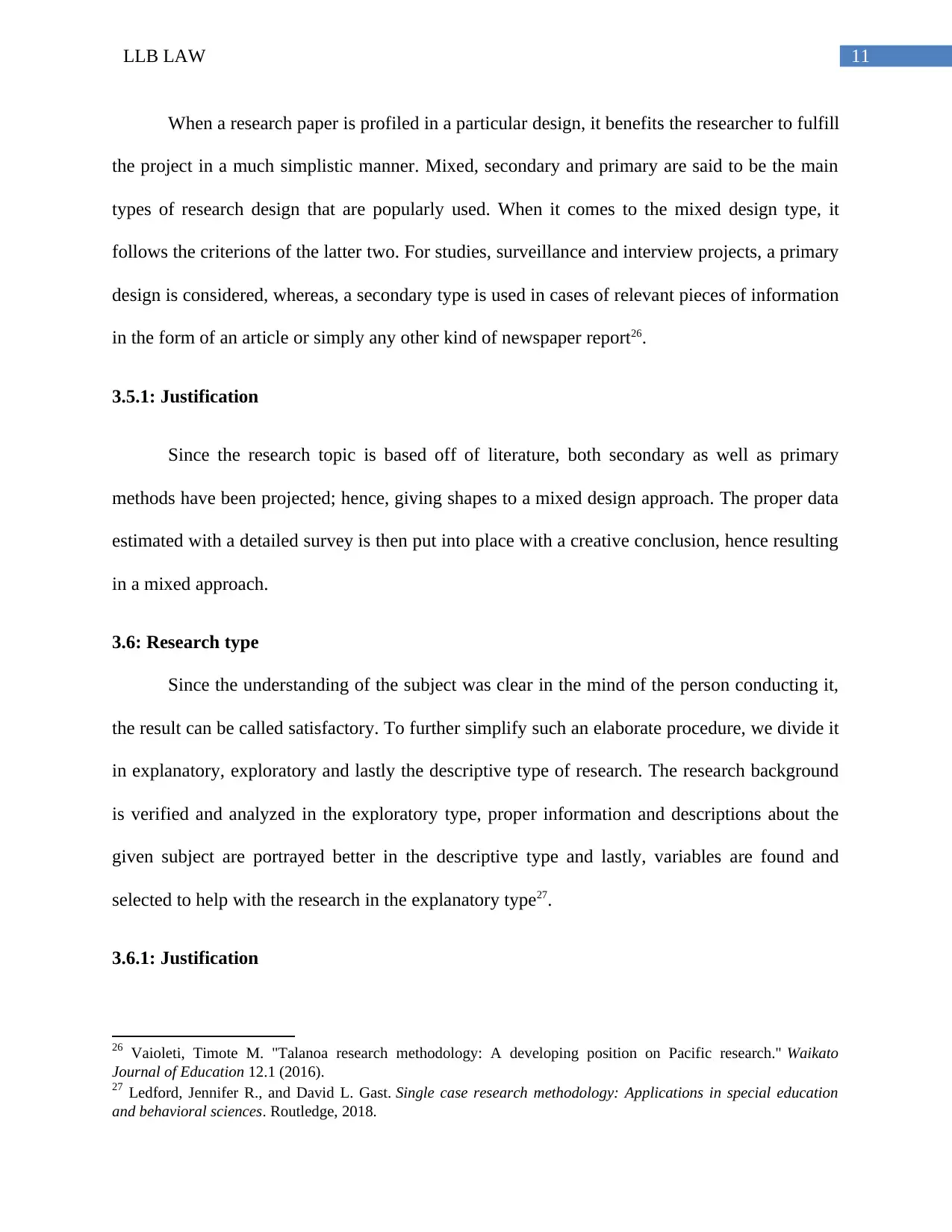
11LLB LAW
When a research paper is profiled in a particular design, it benefits the researcher to fulfill
the project in a much simplistic manner. Mixed, secondary and primary are said to be the main
types of research design that are popularly used. When it comes to the mixed design type, it
follows the criterions of the latter two. For studies, surveillance and interview projects, a primary
design is considered, whereas, a secondary type is used in cases of relevant pieces of information
in the form of an article or simply any other kind of newspaper report26.
3.5.1: Justification
Since the research topic is based off of literature, both secondary as well as primary
methods have been projected; hence, giving shapes to a mixed design approach. The proper data
estimated with a detailed survey is then put into place with a creative conclusion, hence resulting
in a mixed approach.
3.6: Research type
Since the understanding of the subject was clear in the mind of the person conducting it,
the result can be called satisfactory. To further simplify such an elaborate procedure, we divide it
in explanatory, exploratory and lastly the descriptive type of research. The research background
is verified and analyzed in the exploratory type, proper information and descriptions about the
given subject are portrayed better in the descriptive type and lastly, variables are found and
selected to help with the research in the explanatory type27.
3.6.1: Justification
26 Vaioleti, Timote M. "Talanoa research methodology: A developing position on Pacific research." Waikato
Journal of Education 12.1 (2016).
27 Ledford, Jennifer R., and David L. Gast. Single case research methodology: Applications in special education
and behavioral sciences. Routledge, 2018.
When a research paper is profiled in a particular design, it benefits the researcher to fulfill
the project in a much simplistic manner. Mixed, secondary and primary are said to be the main
types of research design that are popularly used. When it comes to the mixed design type, it
follows the criterions of the latter two. For studies, surveillance and interview projects, a primary
design is considered, whereas, a secondary type is used in cases of relevant pieces of information
in the form of an article or simply any other kind of newspaper report26.
3.5.1: Justification
Since the research topic is based off of literature, both secondary as well as primary
methods have been projected; hence, giving shapes to a mixed design approach. The proper data
estimated with a detailed survey is then put into place with a creative conclusion, hence resulting
in a mixed approach.
3.6: Research type
Since the understanding of the subject was clear in the mind of the person conducting it,
the result can be called satisfactory. To further simplify such an elaborate procedure, we divide it
in explanatory, exploratory and lastly the descriptive type of research. The research background
is verified and analyzed in the exploratory type, proper information and descriptions about the
given subject are portrayed better in the descriptive type and lastly, variables are found and
selected to help with the research in the explanatory type27.
3.6.1: Justification
26 Vaioleti, Timote M. "Talanoa research methodology: A developing position on Pacific research." Waikato
Journal of Education 12.1 (2016).
27 Ledford, Jennifer R., and David L. Gast. Single case research methodology: Applications in special education
and behavioral sciences. Routledge, 2018.
⊘ This is a preview!⊘
Do you want full access?
Subscribe today to unlock all pages.

Trusted by 1+ million students worldwide
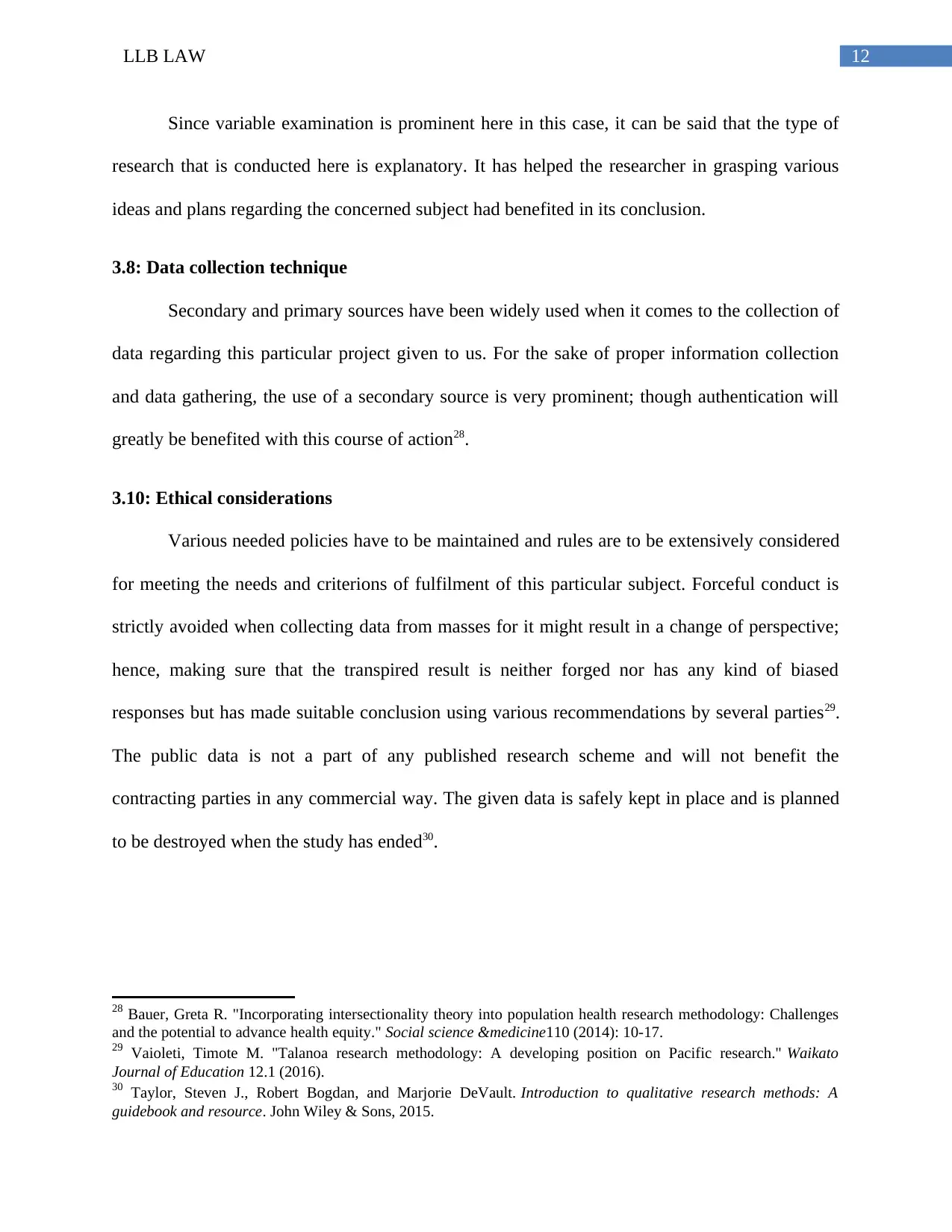
12LLB LAW
Since variable examination is prominent here in this case, it can be said that the type of
research that is conducted here is explanatory. It has helped the researcher in grasping various
ideas and plans regarding the concerned subject had benefited in its conclusion.
3.8: Data collection technique
Secondary and primary sources have been widely used when it comes to the collection of
data regarding this particular project given to us. For the sake of proper information collection
and data gathering, the use of a secondary source is very prominent; though authentication will
greatly be benefited with this course of action28.
3.10: Ethical considerations
Various needed policies have to be maintained and rules are to be extensively considered
for meeting the needs and criterions of fulfilment of this particular subject. Forceful conduct is
strictly avoided when collecting data from masses for it might result in a change of perspective;
hence, making sure that the transpired result is neither forged nor has any kind of biased
responses but has made suitable conclusion using various recommendations by several parties29.
The public data is not a part of any published research scheme and will not benefit the
contracting parties in any commercial way. The given data is safely kept in place and is planned
to be destroyed when the study has ended30.
28 Bauer, Greta R. "Incorporating intersectionality theory into population health research methodology: Challenges
and the potential to advance health equity." Social science &medicine110 (2014): 10-17.
29 Vaioleti, Timote M. "Talanoa research methodology: A developing position on Pacific research." Waikato
Journal of Education 12.1 (2016).
30 Taylor, Steven J., Robert Bogdan, and Marjorie DeVault. Introduction to qualitative research methods: A
guidebook and resource. John Wiley & Sons, 2015.
Since variable examination is prominent here in this case, it can be said that the type of
research that is conducted here is explanatory. It has helped the researcher in grasping various
ideas and plans regarding the concerned subject had benefited in its conclusion.
3.8: Data collection technique
Secondary and primary sources have been widely used when it comes to the collection of
data regarding this particular project given to us. For the sake of proper information collection
and data gathering, the use of a secondary source is very prominent; though authentication will
greatly be benefited with this course of action28.
3.10: Ethical considerations
Various needed policies have to be maintained and rules are to be extensively considered
for meeting the needs and criterions of fulfilment of this particular subject. Forceful conduct is
strictly avoided when collecting data from masses for it might result in a change of perspective;
hence, making sure that the transpired result is neither forged nor has any kind of biased
responses but has made suitable conclusion using various recommendations by several parties29.
The public data is not a part of any published research scheme and will not benefit the
contracting parties in any commercial way. The given data is safely kept in place and is planned
to be destroyed when the study has ended30.
28 Bauer, Greta R. "Incorporating intersectionality theory into population health research methodology: Challenges
and the potential to advance health equity." Social science &medicine110 (2014): 10-17.
29 Vaioleti, Timote M. "Talanoa research methodology: A developing position on Pacific research." Waikato
Journal of Education 12.1 (2016).
30 Taylor, Steven J., Robert Bogdan, and Marjorie DeVault. Introduction to qualitative research methods: A
guidebook and resource. John Wiley & Sons, 2015.
Paraphrase This Document
Need a fresh take? Get an instant paraphrase of this document with our AI Paraphraser

13LLB LAW
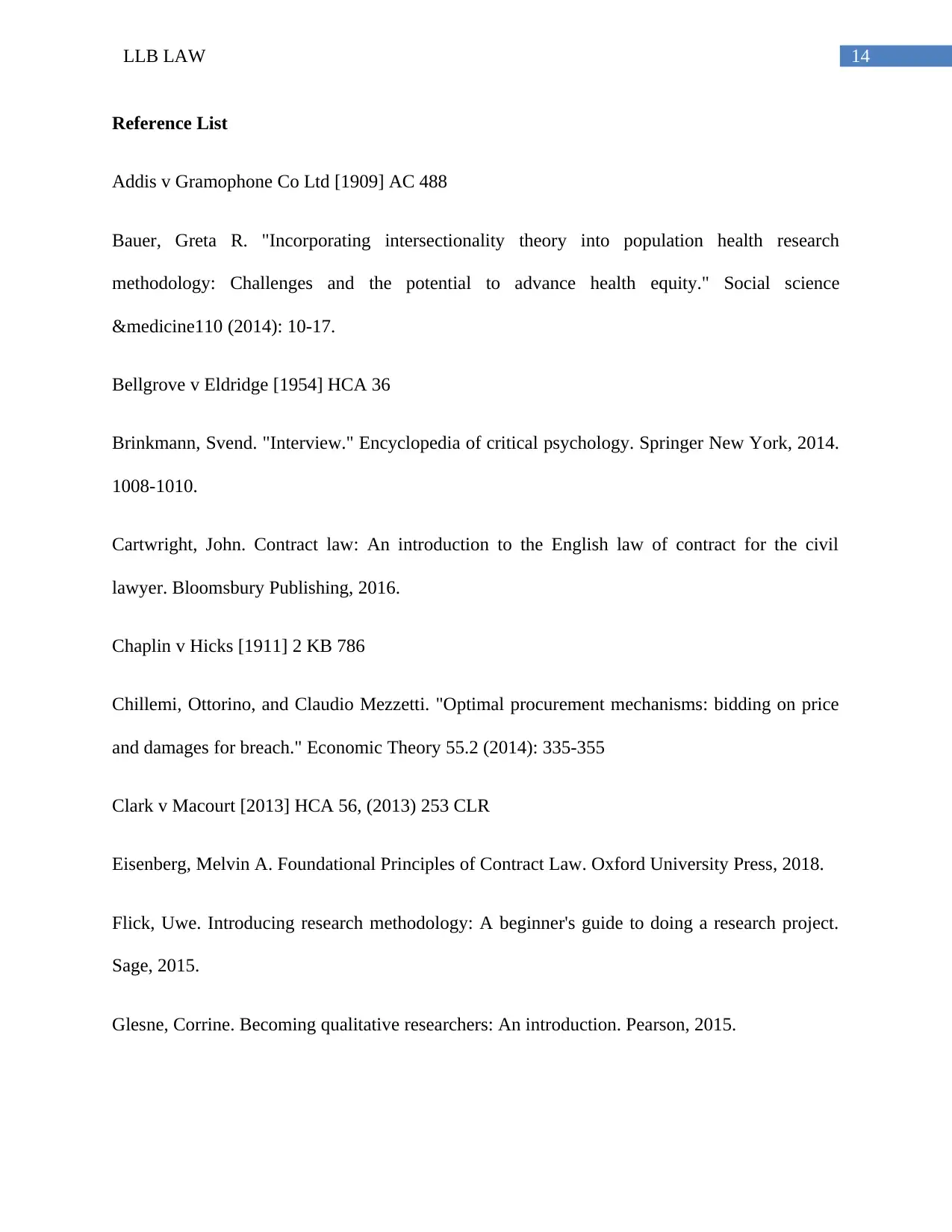
14LLB LAW
Reference List
Addis v Gramophone Co Ltd [1909] AC 488
Bauer, Greta R. "Incorporating intersectionality theory into population health research
methodology: Challenges and the potential to advance health equity." Social science
&medicine110 (2014): 10-17.
Bellgrove v Eldridge [1954] HCA 36
Brinkmann, Svend. "Interview." Encyclopedia of critical psychology. Springer New York, 2014.
1008-1010.
Cartwright, John. Contract law: An introduction to the English law of contract for the civil
lawyer. Bloomsbury Publishing, 2016.
Chaplin v Hicks [1911] 2 KB 786
Chillemi, Ottorino, and Claudio Mezzetti. "Optimal procurement mechanisms: bidding on price
and damages for breach." Economic Theory 55.2 (2014): 335-355
Clark v Macourt [2013] HCA 56, (2013) 253 CLR
Eisenberg, Melvin A. Foundational Principles of Contract Law. Oxford University Press, 2018.
Flick, Uwe. Introducing research methodology: A beginner's guide to doing a research project.
Sage, 2015.
Glesne, Corrine. Becoming qualitative researchers: An introduction. Pearson, 2015.
Reference List
Addis v Gramophone Co Ltd [1909] AC 488
Bauer, Greta R. "Incorporating intersectionality theory into population health research
methodology: Challenges and the potential to advance health equity." Social science
&medicine110 (2014): 10-17.
Bellgrove v Eldridge [1954] HCA 36
Brinkmann, Svend. "Interview." Encyclopedia of critical psychology. Springer New York, 2014.
1008-1010.
Cartwright, John. Contract law: An introduction to the English law of contract for the civil
lawyer. Bloomsbury Publishing, 2016.
Chaplin v Hicks [1911] 2 KB 786
Chillemi, Ottorino, and Claudio Mezzetti. "Optimal procurement mechanisms: bidding on price
and damages for breach." Economic Theory 55.2 (2014): 335-355
Clark v Macourt [2013] HCA 56, (2013) 253 CLR
Eisenberg, Melvin A. Foundational Principles of Contract Law. Oxford University Press, 2018.
Flick, Uwe. Introducing research methodology: A beginner's guide to doing a research project.
Sage, 2015.
Glesne, Corrine. Becoming qualitative researchers: An introduction. Pearson, 2015.
⊘ This is a preview!⊘
Do you want full access?
Subscribe today to unlock all pages.

Trusted by 1+ million students worldwide
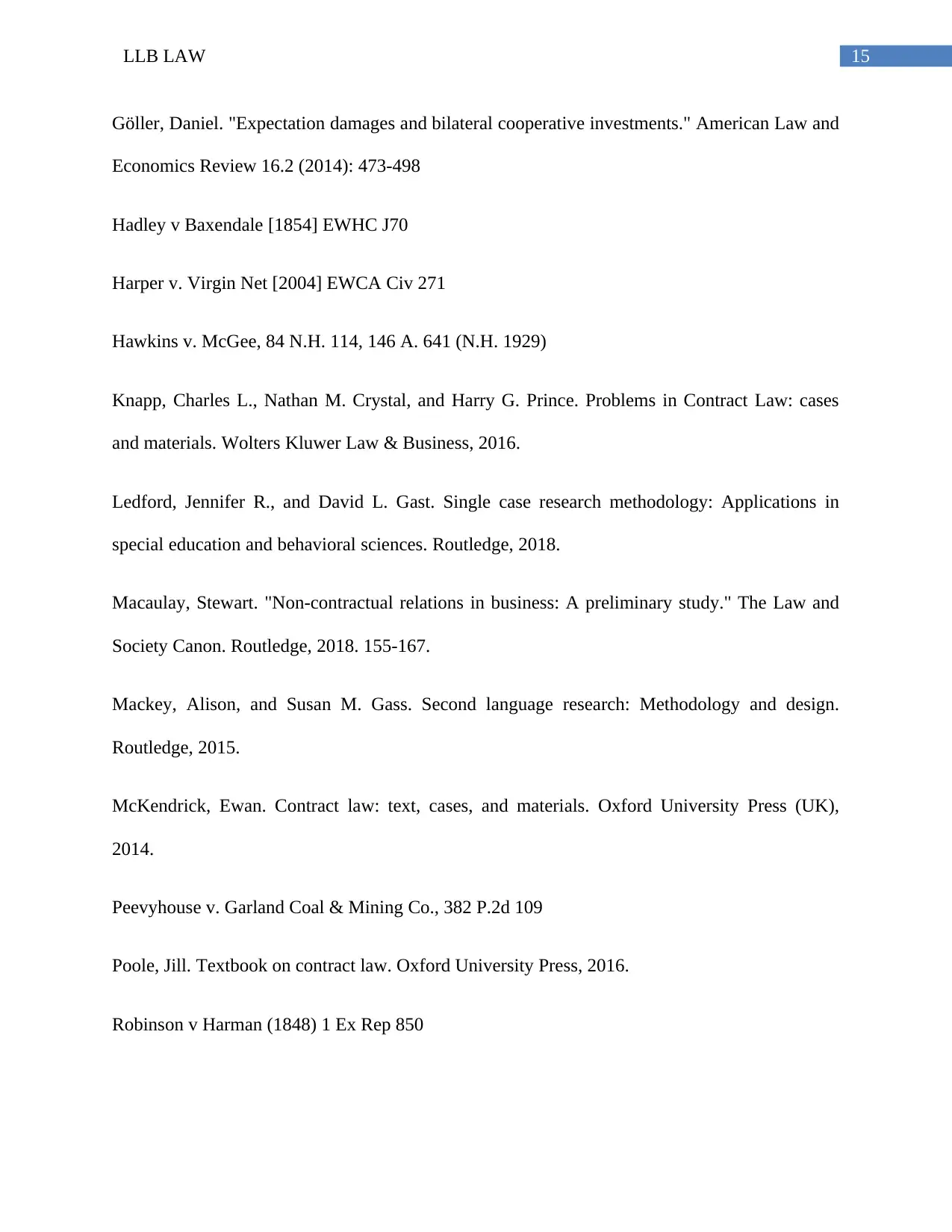
15LLB LAW
Göller, Daniel. "Expectation damages and bilateral cooperative investments." American Law and
Economics Review 16.2 (2014): 473-498
Hadley v Baxendale [1854] EWHC J70
Harper v. Virgin Net [2004] EWCA Civ 271
Hawkins v. McGee, 84 N.H. 114, 146 A. 641 (N.H. 1929)
Knapp, Charles L., Nathan M. Crystal, and Harry G. Prince. Problems in Contract Law: cases
and materials. Wolters Kluwer Law & Business, 2016.
Ledford, Jennifer R., and David L. Gast. Single case research methodology: Applications in
special education and behavioral sciences. Routledge, 2018.
Macaulay, Stewart. "Non-contractual relations in business: A preliminary study." The Law and
Society Canon. Routledge, 2018. 155-167.
Mackey, Alison, and Susan M. Gass. Second language research: Methodology and design.
Routledge, 2015.
McKendrick, Ewan. Contract law: text, cases, and materials. Oxford University Press (UK),
2014.
Peevyhouse v. Garland Coal & Mining Co., 382 P.2d 109
Poole, Jill. Textbook on contract law. Oxford University Press, 2016.
Robinson v Harman (1848) 1 Ex Rep 850
Göller, Daniel. "Expectation damages and bilateral cooperative investments." American Law and
Economics Review 16.2 (2014): 473-498
Hadley v Baxendale [1854] EWHC J70
Harper v. Virgin Net [2004] EWCA Civ 271
Hawkins v. McGee, 84 N.H. 114, 146 A. 641 (N.H. 1929)
Knapp, Charles L., Nathan M. Crystal, and Harry G. Prince. Problems in Contract Law: cases
and materials. Wolters Kluwer Law & Business, 2016.
Ledford, Jennifer R., and David L. Gast. Single case research methodology: Applications in
special education and behavioral sciences. Routledge, 2018.
Macaulay, Stewart. "Non-contractual relations in business: A preliminary study." The Law and
Society Canon. Routledge, 2018. 155-167.
Mackey, Alison, and Susan M. Gass. Second language research: Methodology and design.
Routledge, 2015.
McKendrick, Ewan. Contract law: text, cases, and materials. Oxford University Press (UK),
2014.
Peevyhouse v. Garland Coal & Mining Co., 382 P.2d 109
Poole, Jill. Textbook on contract law. Oxford University Press, 2016.
Robinson v Harman (1848) 1 Ex Rep 850
Paraphrase This Document
Need a fresh take? Get an instant paraphrase of this document with our AI Paraphraser
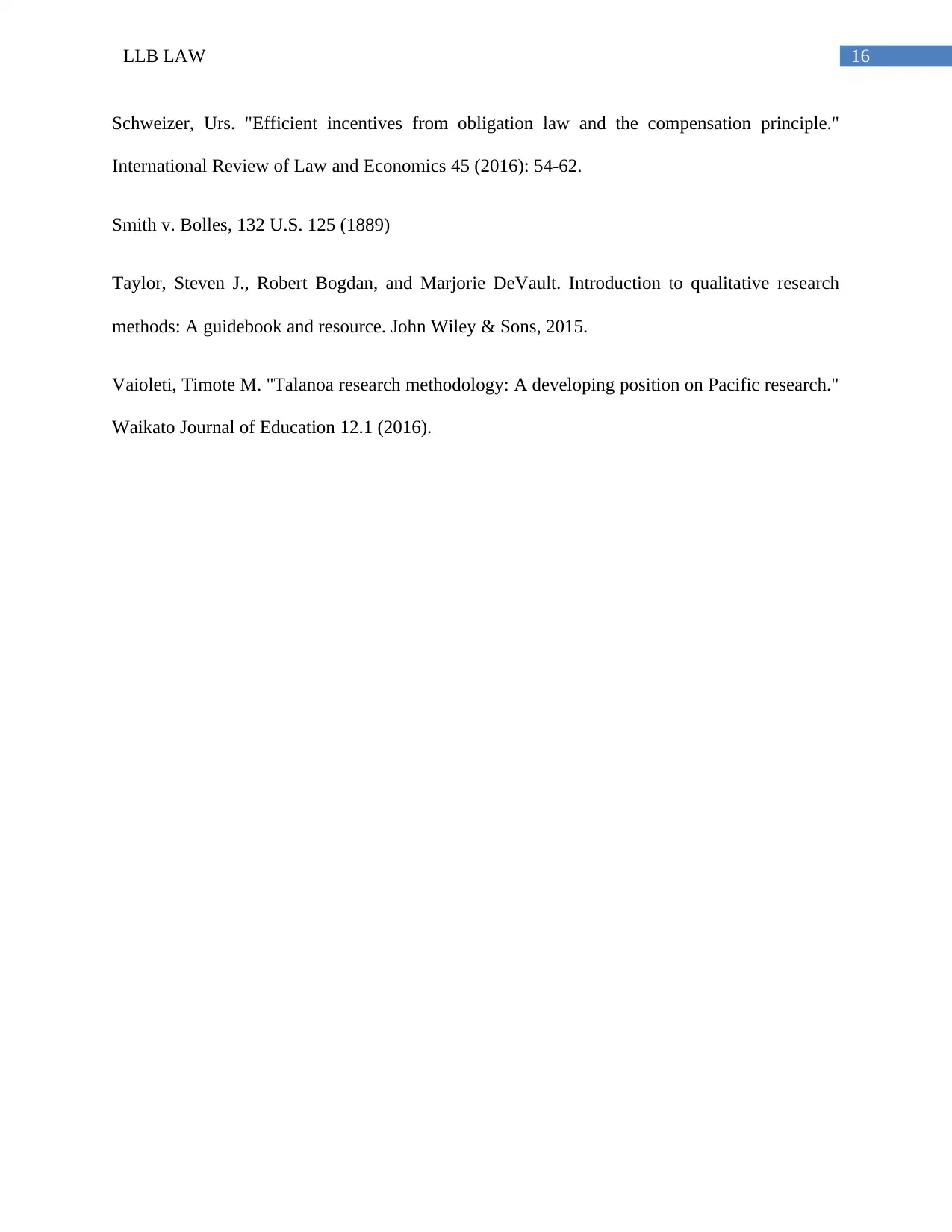
16LLB LAW
Schweizer, Urs. "Efficient incentives from obligation law and the compensation principle."
International Review of Law and Economics 45 (2016): 54-62.
Smith v. Bolles, 132 U.S. 125 (1889)
Taylor, Steven J., Robert Bogdan, and Marjorie DeVault. Introduction to qualitative research
methods: A guidebook and resource. John Wiley & Sons, 2015.
Vaioleti, Timote M. "Talanoa research methodology: A developing position on Pacific research."
Waikato Journal of Education 12.1 (2016).
Schweizer, Urs. "Efficient incentives from obligation law and the compensation principle."
International Review of Law and Economics 45 (2016): 54-62.
Smith v. Bolles, 132 U.S. 125 (1889)
Taylor, Steven J., Robert Bogdan, and Marjorie DeVault. Introduction to qualitative research
methods: A guidebook and resource. John Wiley & Sons, 2015.
Vaioleti, Timote M. "Talanoa research methodology: A developing position on Pacific research."
Waikato Journal of Education 12.1 (2016).
1 out of 17
Related Documents
Your All-in-One AI-Powered Toolkit for Academic Success.
+13062052269
info@desklib.com
Available 24*7 on WhatsApp / Email
![[object Object]](/_next/static/media/star-bottom.7253800d.svg)
Unlock your academic potential
© 2024 | Zucol Services PVT LTD | All rights reserved.




